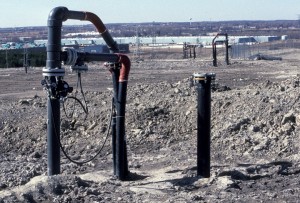 It may soon get harder and more expensive to recycle your solid waste. As the Associated Press reported, stockpiled recyclables are going nowhere these days:
It may soon get harder and more expensive to recycle your solid waste. As the Associated Press reported, stockpiled recyclables are going nowhere these days:
It all stems from a policy shift by China, long the world’s leading recyclables buyer. At the beginning of the year it enacted an anti-pollution program that closed its doors to loads of waste paper, metals or plastic unless they’re 99.5 percent pure. That’s an unattainable standard at U.S. single-stream recycling processing plants designed to churn out bales of paper or plastic that are, at best, 97 percent free of contaminants such as foam cups and food waste.
The resulting glut of recyclables has caused prices to plummet from levels already depressed by other economic forces, including lower prices for oil, a key ingredient in plastics.
As one recycler commented, a bale of mixed paper was worth about $100 per ton a year ago, but now requires payment of $15 to dispose of it.
There may not be much we can do to get China to change its policy, particularly with Trump’s trade war raging. And it may not be a bad thing, from an environmental perspective, as anecdotal reports indicated that American companies had very little insight into what happened to recyclables once they were shipped off to China on empty freight vessels.
So Americans are likely to see higher prices for waste disposal rates soon, as companies renegotiate contracts with municipal governments. And we’re also likely going to have to be more methodical about how we recycle, such as by cleaning out bottles and cans better and separating recyclables into distinct bins by product type.
People don’t necessarily associate landfills and solid waste with our energy and climate issues, but they are quite related. The more trash that goes to landfills, the more they emit methane, a powerful greenhouse gas, as the trash decomposes over time. Meanwhile, that methane could be harvested, purified, and used to generate electricity.
The issue may be even more pressing now that the U.S. Environmental Protection Agency appears to have badly underestimated the amount of trash Americans are sending to landfills:
For years, the U.S. Environmental Protection Agency relied on estimates to determine how much trash was being sent to landfills. But in 2010, the agency required most municipal landfills to measure and report how much trash was heading into the dumps, as part of an effort to lower heat-trapping methane emissions. Researchers at Yale University looked at the records for more than 1,200 landfills and calculated amounts, predominantly based on weights.
They figured it was 289 million tons in 2012, according to a study published Monday in the journal Nature Climate Change. For the same year, EPA estimated the figure to be 135 million tons.
That means an estimated 34.5% recycling rate may actually be 21.4%. That’s a lot of extra garbage at landfills that produce an estimated 91% of all methane emissions.
This information should give policy makers incentive to address two issues: first, ensure that we do a better job reducing landfill waste through more recycling and reusing of materials, plus better packaging; and second, we need to capture more methane from landfills to generate electricity, which can be done via underground pipes that let the methane seep into them.
It’s a multiple win scenario: less trash, less methane, and more renewable energy.



